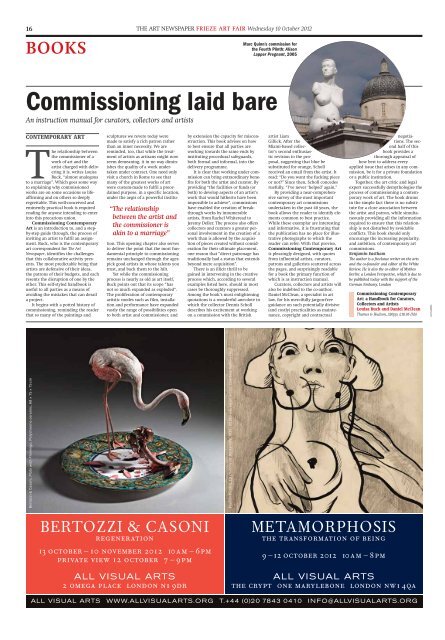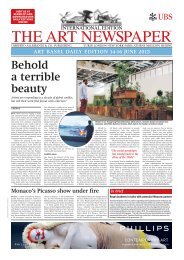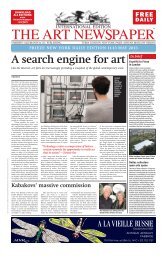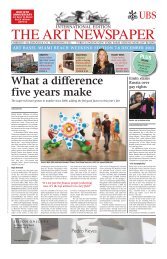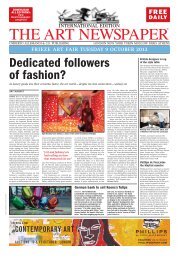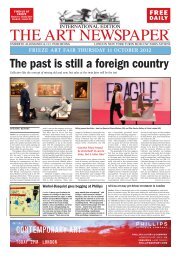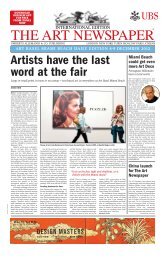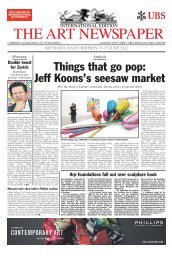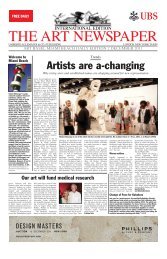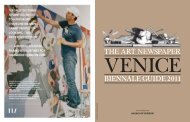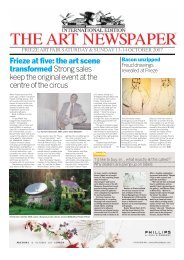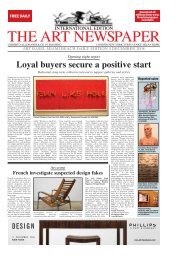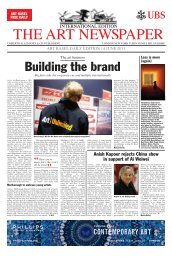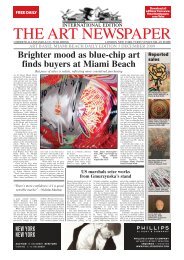Issue 2 - The Art Newspaper
Issue 2 - The Art Newspaper
Issue 2 - The Art Newspaper
You also want an ePaper? Increase the reach of your titles
YUMPU automatically turns print PDFs into web optimized ePapers that Google loves.
16<br />
BOOKS<br />
CONTEMPORARY ART<br />
<strong>The</strong> relationship between<br />
the commissioner of a<br />
work of art and the<br />
artist charged with delivering<br />
it is, writes Louisa<br />
Buck, “almost analogous<br />
to a marriage”. Which goes some way<br />
to explaining why commissioned<br />
works are on some occasions so lifeaffirming<br />
and on others so deeply<br />
regrettable. This well-conceived and<br />
eminently practical book is required<br />
reading for anyone intending to enter<br />
into this precarious union.<br />
Commissioning Contemporary<br />
<strong>Art</strong> is an introduction to, and a stepby-step<br />
guide through, the process of<br />
inviting an artist to fulfil an assignment.<br />
Buck, who is the contemporary<br />
art correspondent for <strong>The</strong> <strong>Art</strong><br />
<strong>Newspaper</strong>, identifies the challenges<br />
that this collaborative activity presents.<br />
<strong>The</strong> most predictable being that<br />
artists are defensive of their ideas,<br />
the patrons of their budgets, and each<br />
resents the disruption of one by the<br />
other. This self-styled handbook is<br />
useful to all parties as a means of<br />
avoiding the mistakes that can derail<br />
a project.<br />
It begins with a potted history of<br />
commissioning, reminding the reader<br />
that so many of the paintings and<br />
sculptures we revere today were<br />
made to satisfy a rich patron rather<br />
than an inner necessity. We are<br />
reminded, too, that while the treatment<br />
of artists as artisans might now<br />
seem demeaning, it in no way diminishes<br />
the quality of a work undertaken<br />
under contract. One need only<br />
visit a church in Rome to see that<br />
many of the greatest works of art<br />
were custom-made to fulfil a preordained<br />
purpose, in a specific location,<br />
under the aegis of a powerful institu-<br />
tion. This opening chapter also serves<br />
to deliver the point that the most fundamental<br />
principle to commissioning<br />
remains unchanged through the ages:<br />
pick good artists in whose talents you<br />
trust, and back them to the hilt.<br />
Yet while the commissioning<br />
process is nearly as old as art itself,<br />
Buck points out that its scope “has<br />
not so much expanded as exploded”.<br />
<strong>The</strong> proliferation of contemporary<br />
artistic modes such as film, installation<br />
and performance have expanded<br />
vastly the range of possibilities open<br />
to both artist and commissioner, and<br />
by extension the capacity for misconstruction.<br />
This book advises on how<br />
to best ensure that all parties are<br />
working towards the same ends by<br />
instituting procedural safeguards,<br />
both formal and informal, into the<br />
delivery programme.<br />
It is clear that working under commission<br />
can bring extraordinary benefits<br />
for both the artist and curator. By<br />
providing “the facilities or funds (or<br />
both) to develop aspects of an artist’s<br />
work that would hitherto have been<br />
impossible to achieve”, commissions<br />
have enabled the creation of breakthrough<br />
works by innumerable<br />
artists, from Rachel Whiteread to<br />
Jeremy Deller. <strong>The</strong> process also offers<br />
collectors and curators a greater personal<br />
involvement in the creation of a<br />
work than is allowed by the acquisition<br />
of pieces created without consideration<br />
for their ultimate placement,<br />
one reason that “direct patronage has<br />
traditionally had a status that extends<br />
beyond mere acquisition”.<br />
<strong>The</strong>re is an illicit thrill to be<br />
gained in intervening in the creative<br />
process which, according to several<br />
examples listed here, should in most<br />
cases be thoroughly suppressed.<br />
Among the book’s most enlightening<br />
quotations is a wonderful anecdote in<br />
which the collector Dennis Scholl<br />
describes his excitement at working<br />
on a commission with the British<br />
Marc Quinn’s commission for<br />
the Fourth Plinth: Alison<br />
Lapper Pregnant, 2005<br />
Commissioning laid bare<br />
An instruction manual for curators, collectors and artists<br />
Bertozzi & Casoni, Plate with Flamingo, Polychrome ceramic, 68 × 75 × 75cm<br />
BERTOZZI & CASONI<br />
regeneration<br />
13 october ‒ 10 november 2012 10am ‒ 6pm<br />
private view 12 october 7 ‒ 9pm<br />
ALL VISUAL ARTS<br />
2 omega place london n1 9dr<br />
THE ART NEWSPAPER FRIEZE ART FAIR Wednesday 10 October 2012<br />
“<strong>The</strong> relationship<br />
between the artist and<br />
the commissioner is<br />
akin to a marriage”<br />
artist Liam<br />
Gillick. After the<br />
Miami-based collector’s<br />
second enthusiastic<br />
revision to the proposal,<br />
suggesting that blue be<br />
substituted for orange, Scholl<br />
received an email from the artist. It<br />
read: “Do you want the fucking piece<br />
or not?” Since then, Scholl concedes<br />
ruefully, “I’ve never ‘helped’ again.”<br />
By providing a near-comprehensive<br />
survey of the most important<br />
contemporary art commissions<br />
undertaken in the past 40 years, the<br />
book allows the reader to identify elements<br />
common to best practice.<br />
While these exemplar are interesting<br />
and informative, it is frustrating that<br />
the publication has no place for illustrative<br />
photographs to which the<br />
reader can refer. With that proviso,<br />
Commissioning Contemporary <strong>Art</strong><br />
is pleasingly designed, with quotes<br />
from influential artists, curators,<br />
patrons and gallerists scattered across<br />
the pages, and surprisingly readable<br />
for a book the primary function of<br />
which is as instruction manual.<br />
Curators, collectors and artists will<br />
also be indebted to the co-author,<br />
Daniel McClean, a specialist in art<br />
law, for his mercifully jargon-free<br />
guidance on such potentially divisive<br />
(and costly) practicalities as maintenance,<br />
copyright and contractual<br />
negotiations.<br />
<strong>The</strong> second<br />
half of this<br />
book provides a<br />
thorough appraisal of<br />
how best to address every<br />
applied issue that arises in any commission,<br />
be it for a private foundation<br />
or a public institution.<br />
Together, the art critic and legal<br />
expert successfully demythologise the<br />
process of commissioning a contemporary<br />
work of art. <strong>The</strong> book drums<br />
in the simple fact there is no substitute<br />
for a close association between<br />
the artist and patron, while simultaneously<br />
providing all the information<br />
required to ensure that this relationship<br />
is not disturbed by avoidable<br />
conflicts. This book should only<br />
encourage the increasing popularity,<br />
and ambition, of contemporary art<br />
commissions.<br />
Benjamin Eastham<br />
<strong>The</strong> author is a freelance writer on the arts<br />
and the co-founder and editor of the White<br />
Review. He is also the co-editor of Mythos<br />
Berlin: a London Perspective, which is due to<br />
be published today with the support of the<br />
German Embassy, London<br />
METAMORPHOSIS<br />
the transformation of being<br />
9 ‒12 october 2012 10am ‒ 8pm<br />
ALL VISUAL ARTS<br />
the crypt one marylebone london nw1 4qa<br />
ALL VISUAL ARTS WWW.ALLVISUALARTS.ORG T.+44 (0)20 7843 0410 INFO@ALLVISUALARTS.ORG<br />
Francis Picabia, La Chienne de Baskerville, 1932–33 (detail), oil on wood. Courtesy Gallerie Haas<br />
Commissioning Contemporary<br />
<strong>Art</strong>: a Handbook for Curators,<br />
Collectors and <strong>Art</strong>ists<br />
Louisa Buck and Daniel McClean<br />
Thames & Hudson, 320pp, £18.95 (hb)<br />
LOZ FLOWERS


